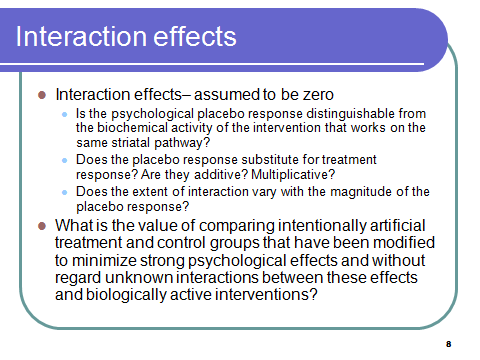|
Perry Cohen, Ph.D. presents Sham Neurosurgical Procedures in Clinical Trials: Patient Activists’ Perspectives at the NIH conference
Sham Neurosurgical Procedures in Clinical Trials for Neurodegenerative Diseases: Scientific and Ethical Considerations
held on June 30 and July 1, 2010
Page 1 - 2 - 3 - 4 - 5 - 6 - 7 - 8 - 9 - 10 - 11 - 12 - 13

Interaction Effects
Sham controlled trials assume that purely psychological effects from patient expectations and the biochemical effects of introducing an active intervention are distinguishable independent variables, and they can be added or subtracted validly. This assumption may be close to being accurate for sugar pill placeboes, but is it true for the more powerful effect from placebo brain surgery?
What we don’t know is how placebo responses and treatments interact with each other. Are placebo responders the same as treatment responders? Do placebo response and treatment response substitute for each other in the treatment group? Are they additive? Or is there a dynamic mutual reinforcement such that there is a multiplier effect much greater than additive? Or are they distinct and independent biological and psychological effects, no matter how large and powerful the placebo effect, as assumed by the linear experimental model. Could there be thresholds, or triggers, or therapeutic concentrations needed to jump start an active biological treatment, like drawing a line in front of a frozen PWP to help initiate activity?
Are there other artifacts introduced that are a consequence of the experimental design? What is the psychological effect on PWP of prolonged deception and uncertainty from maintaining the blind? Does this interfere with optimal care? Are the placebo effects diluted by separating into two artificial groups (with no correlate outside the experiment) both with 50% chance of getting the real thing? The assumptions in the experimental model about interactions --zero interaction-- may be true for a sugar pill placebo with minimal interaction, but could they be entirely different for the much larger placebo effect from sham brain surgery?
To make the risk to volunteers worthwhile, as a minimum researchers need to justify the validity of the analysis to compare sham groups to treatment groups. To show that we are not introducing bias toward type 2 errors we must demonstrate that:
 |
the psychological effects of treatment are distinguishable from the biological effects along the same pathway.
|
 |
the placebo effects and treatment effects add to each other and do not multiply or compound or substitute
|
 |
the magnitude of the placebo response has no impact on these interactions
|
But even if we show that we are not introducing type 2 bias, what is the value to patients to eliminate the psychological effects? And is it a valid test if we try to minimize these healing effects?
Go Back Go Forward
Page 1 - 2 - 3 - 4 - 5 - 6 - 7 - 8 - 9 - 10 - 11 - 12 - 13
|
